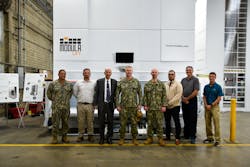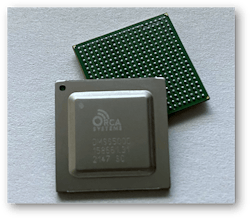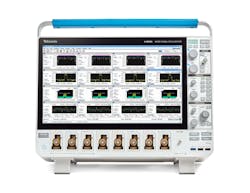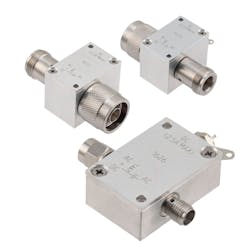The considerable U.S. investment in military technology and advancements often have been a boon for civil purposes. The T-shirt you may be wearing in the Jeep you're driving listening to your satellite navigation system directing you to camp site where you liberally apply bug spray all have their roots in solving military problems.
While also developing breakthroughs of their own, the U.S. Department of Defense (DOD) also is leaning heavily on civilian advancements, and perhaps none more to a transformative degree than radio frequency (RF) and microwave technology, thanks to 5G networking capabilities.
"Historically, military technology advancements have driven civil applications; however, with 5G it is the opposite," says Dave Slack, director of engineering at Times Microwave in Wallingford, Conn. "The growing use of 5G technology in civil applications is driving the military advancements. It started with the civil applications in the information technology side and now military applications are looking for LTE feeds for anything from GPS to autonomous vehicles."
As 5G technology matures, more of the RF spectrum is being used, which enables advances made possible by newer millimeter-wave bands. Baljit Chandhoke, a product manager for Microchip Technology Inc. in Chandler, Ariz., says that cellular networks are able to bring high-speed connectivity to the battlefield, while minimizing vulnerabilities like electronic warfare (EW) jamming.
"New generations of millimeter-wave 5G communications solutions, by virtue of their speed, ultra-wide bandwidth, and low latency for broadband communication,Christopher White, director of wireless applications and systems at Tektronix in Beaverton, Ore., says that with millimeter-wave operations accelerating technological progress, there's a concerted effort to build the needed infrastructure to support it while also designing a desirable user experience, which he says is the true measure of 'quality of service' (Qos).
"The ability to flexibly allocate a service-driven link speed is key," White says. "Infrastructure companies that are carefully planning their network infrastructure to map to this model help to move the needle here."
Industry investments
Initial large investments in millimeter-wave have continued boosting this technology. "The focus on millimeter-wave technology early on drove a massive amount of R&D [research and development] spending on higher frequency component and system architectures, materials, and processes. This benefits the economics of higher-frequency systems in the defense sector as well, and ultimately reinforces the commercial millimeter-wave business case, hopefully spurring more investment into deployment of new infrastructure."
5G is putting actional intelligence into the hands of commanders and warfighters faster than ever, points out Odile Ronat, director of product marketing, aerospace and defense, at SiTime Corp. in Santa Clara, Calif.
"Every second counts in defense: getting seamless, ultra-fast, secure connectivity to get a real-time picture of the dynamic environment on land, air, sea, even in environmentally stressful conditions, is a basic requirement, Ronat says. "5G enhanced connectivity will enable the military to deliver decisive action even faster and it will allow for the development of new capabilities that could transform the U.S. Defense operations and services."
Piyush Sevalia, executive vice president of marketing at SiTime concurred with his colleague regarding speed, and notes that 5G systems are also helping to achieve DOD initiatives.
In addition to faster communications and dissemination of intelligence, 5G speeds also are enabling machine autonomy, says Times Microwave's Slack.
"There are a number of trends we’re seeing for RF/microwave in the military-aerospace sector," Slack says. "One of the big ones is 5G for equipment that operates autonomously. The speed and low latency of 5G are a huge advantage for the military. They want to communicate and control without wires for instantaneous situational awareness. 5G also provides greater security and provides a replacement for dependency on radio."
Commercial concerns
While 5G capabilities are driving the speed and efficacy of battlefield intelligence dissemination, the spectrum in which it operates is creating headaches for commercial aerospace.
The Federal Aviation Administration (FAA) has been grappling with how to ensure the safety of commercial aircraft with 5G towers near large airports.
Specifically, the FAA has cited potential interference from 5G towers affecting radio altimeters on board passenger aircraft. The altimeters operate in the C-band, like 5G signals. While there isn't overlap on frequencies, the FAA worries that the altimeters won't be able to filter out the cellular traffic.
In November 2022, the FAA reported approximately 80 instances where they believe 5G signals interfered with commercial aircraft avionics.
“The FAA has received several hundred reports of possible 5G interference and, as of mid-September, we have been unable to rule out 5G in approximately 80 cases,” the FAA told the publication Flight Global in November. “None of these resulted in safety-related effects, and none affected a direct aircraft control inputAccording to Vox, nearly 90 million 5G devices have been shipped in the U.S. The C-band frequency used by 5G operates between 3.7 and 3.98 GHz.
Reuters obtained a letter dated 21 Oct. 2022 in which acting FAA Administrator Billy Nolen cited industry data established "aviation safety would be compromised if the U.S. government does not codify certain additional operating limits in the 5G C-Band environment."
The concerns stem from 5G affecting aircraft altimeters which could prove disastrous if a pilot needed to land without a visual approach. Nolan's letter noted that if the Federal Communications Commission mitigates the risk to altimeters, the "FAA would be forced to take immediate steps to ensure the safety of the traveling public, raising the likelihood of flight disruptions across the United States."
While the interference issue is causing a lot of headaches in the commercial aerospace sector, Textronix's White says that there may be a positive outcome as industry adopts more understanding in managing the RF spectrum.
"5G deployments in the sub-6 GHz range have exposed some interoperability challenges that exist with the current allocated spectrum, like proximity to frequencies used by avionic radio altimeters," White says. "Active deployment of 5G networking forces conversations about more efficient spectrum management and allocation procedures across industries and use cases, which is a good thing."
Companies like FreeFlight Systems in Irving, Texas, and Marlborough, Massachusetts' APITech have released filtration products or 5G-tolerant altimeter upgrades, the FAA is taking a cautious approach regarding cellular networks that may affect avionics.
"The U.S. airspace is the most complex in the world, and the FAA holds ourselves and our aviation sector to the highest safety standards," the agency wrote in a notice regarding 5G concerns. "Deployments of 5G technology in other countries often involve different conditions than those proposed for the U.S., including lower power levels; antennas adjusted to reduce potential interference to flights; different placement of antennas relative to airfields; and frequencies with a different proximity to frequencies used by aviation equipment."
Beyond 5G
Of course, the military and aerospace technology industry is delivering more than 5G when it comes to RF and microwave solutions. Private companies and nations across the globe are launching satellites for myriad purposes, including military and civilian communications.
Textronix's White says that the highest-level driver of trends in the RF/microwave sector is "the push for spectrum superiority, which includes ensuring electronic and communications system security."
Beyond security, White explains that much of the progress in this space is driven by the proliferation and progress of artificial intelligence and machine learning plus its implications for battlefield operations.
"Increased agility offers advantages in conflict and the ability of systems to avoid the impacts of [electronic warfare] means more robust operations. The range of viable applications of AI/ML for RF systems continues due to advances in the effectiveness and efficiency of AI/ML algorithms and the platforms on which they can be developed, validated and deployed," White says.
What's next?
While industry is still harnessing what's possible with forward-deployed 5G networks, the DOD has their eyes on what comes after. Like the hardware on which communications run, the networks that power them have their eyes on open standards. In February, the DOD launched a trio of projects as part of its Innovate Beyond 5G initiative, which is a collaborative partnership with the department, industry, and academia.
Open6G aims to build 6G systems research on open radio access networks (Open RAN). The DOD says that Open6G is a new industry-university cooperative effort that aims to jumpstart 6G systems research on open radio access networks (Open RAN).
"The effort will focus on Open RAN research and open source implementation of 5G protocol stack features to support emerging beyond/enhanced 5G applications," DOD wrote when the program was announced in August. "Open6G will serve as the DOD’s hub for development, testing, and integration of trusted enhancements, supporting an industry and federal government NextG ecosystem pursuing 6G technology goals. Led by a $1.77 million anchor award from IB5G, the project is managed by Northeastern University’s Kostas Research Institute through a cooperative agreement with the Army Research Laboratory. The technical effort will be housed at Northeastern University’s Institute for Wireless Internet of Things."
The DOD also is looking to enable open systems standards within 5G networks as well. In February, the DOD announced that it was launching a competition in concert with the National Telecommunications and Information Administration (NTIA) with $7 million in awards.
The DOD says that the competition aims to accelerate the adoption and development of an open, interoperable, secure, multi-vendor 5G ecosystem.
"Such an ecosystem will spur a more competitive and diverse telecommunications supply chain, drive down costs for consumers and network operators, and bolster U.S. leadership in the wireless sector," DOD wrote.
"A competitive wireless ecosystem is vital for our domestic and economic security. The research conducted from this competition will benefit everything from our cellphones to the secure radio networks needed for our national defense," said Alan Davidson, Assistant Secretary of Commerce for Communications and Information. "To ensure the U.S. remains a global leader in wireless innovation, we are looking for a diverse set of companies and researchers from across the 5G industry to come together and participate to come together and participate in this challenge competition."
More information on RF and microwave products and companies is online in the Military & Aerospace Electronics Buyers Guide at https://www.militaryaerospace.com/directory/rf-and-microwave.







